
The most-used essential technique for optimizing production systems, given its effectiveness and reliability, is Nodal Analysis. With this technique, both surface and subsoil infrastructure can be adapted to meet system requirements and determine the real production potential of wells associated with heavy oil reservoirs. It also helps determine the differential volume existing between actual well production and the calculated production that they should provide, considering flow restrictions. In short, Nodal Analysis consists of quantifying the system’s total production capacity under real operating scenarios for each particular well.
Nodal Analysis in wells using cyclic steam injection.
In addition to the original energy balance required between the reservoir and installed infrastructure (surface-subsoil) to establish production capacity in cyclic steam injection processes, it is important to consider two elements:
- The effect of heating, induced by the sweep of the steam chamber in the drainage area of the wells under study.
- The post-injection production cycle uptime. In many cases, this is determined by statistical analysis of completed wells that have been subjected to cyclic steam injection processes in either the same reservoir or one with similar properties.
Oil flow can be determined through the execution of consecutive tests using multiphase equipment during the hot production stage to estimate or predict the inflow curve of reservoir fluids.
There may be a certain difference in the results obtained from Nodal Analysis, according to the points (nodes) used as a basis. However, the energy balance is traditionally carried out at the bottom of the well, but the current availability of production process simulators allows the balance to be established at other points of the production process path. This includes the wellhead and surface separators, among others. These simulators become even more versatile when additional criteria are added: The effect of steam injection and the duration of the hot fluid flow. By combining these techniques, it is possible to more accurately quantify the system’s total production capacity.
Nakasawa focuses its attention on the development of innovative technologies and optimal completion schemes (surface-subsoil) to guarantee high efficiency and productivity in the thermal enhanced oil recovery for heavy crude oil processes.
To read the full article, download here.


